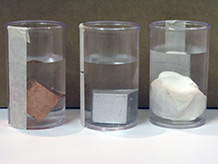What causes the water level to rise?
4. Make meaning
Purpose of the discussion
The purpose of the discussion is to construct an explanation together of what causes the water to rise. The resulting explanation should be consistent with observations and evidence. Begin the discussion by returning to the investigation question.
Engage students in the focus question
Weight or volume, which causes the water level to rise?
Engage students in the topic by asking them to talk a couple of minutes to talk with a partner about their claims and the evidence that supports their claims. Provide three 150cc containers with equal volumes of water and an aluminum, copper, and plastic modeling clay cube for students to refer to during their discussion, as well as the data they recorded in their notebooks.
Open the full-class discussion with the focus question.
Is it weight or volume that causes the water level to rise?

Supporting questions
- What do the data tell us? (Refer to the class data chart.)
- What claim can you make: can you claim it's the volume that causes the water to rise? Or do you claim it's weight? What is your evidence that supports your claim? And what is your reasoning?
- How do you explain the results?
Note: From their investigation, students have evidence to reason that weight is not a factor in raising the water level.
The aluminum and copper cubes weigh different amounts but the water levels rose equally.
The aluminum and plastic modeling clay cubes weigh the same but the water levels rose unequally.
Students also have evidence to reason that volume is a factor in raising the water level.
The aluminum and copper cubes have equal volumes and the water levels rose equally.
The aluminum and plastic modeling clay cubes have different volumes, and the water levels rose unequally.
The underlying reason — the explanation — why the water rises is because two objects cannot occupy the same 3-D space at the same time. Volume, and not weight, is the property of an object that describes the amount of 3-D space an object takes up.
Students may not be able to clearly articulate this explanation; they may say the rock “pushed the water out of the way”. In response, you may ask, “Why? Why couldn't the water just stay in the same place after the rock was dropped in?”
Support the discussion with "moves" such as:
- Who wants to repeat (student A)'s explanation using different words?
- Do you agree or disagree? Does that reasoning make sense to you?
When you think the group is convinced that it is volume that determines how much water is displaced, ask students for an explanation of the displacement phenomenon.
- Does it make sense that it's volume and not the weight of an object that determines how high the water will rise? How do you explain this?
- What happens to the water when an object sinks in it? Where does it go?
- Water will go in whatever direction the shape of the container allows. In a straight-sided container it will move straight up. In a bowl with sloping sides, it will move up and sideways. If the container is full, the water will overflow.
- Have you seen water displacement happen anyplace else?
- In the bath tub, in a cooking pot, in a puddle when you step in it.
Summarize the discussion and recap the investigation
Here is what I think I heard you say:
Use the same language that students have used to summarize the discussion. Include student comments that address claims and evidence, but be sure to highlight students' reasoning and explanations of displacement.
Describe the initial observations using rocks, and the dilemma of not being able to determine whether it was weight or volume that was causing the water level to rise. The rock with the greater volume also weighed more.
The tests students did using the three cubes allowed us to separate weight from volume; in both tests, it became clear that volume was the property that determined how much the water rose, and weight did not make a difference.
A key concept is that two objects cannot occupy the same 3-D space at the same time.





